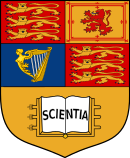 | |||||||||||||||||||||||
| Motto | Scientia, imperii decus et tutamen (Latin) | ||||||||||||||||||||||
|---|---|---|---|---|---|---|---|---|---|---|---|---|---|---|---|---|---|---|---|---|---|---|---|
Motto in English | "Scientific knowledge, the crowning glory and the safeguard of the empire" | ||||||||||||||||||||||
| Type | Public research university | ||||||||||||||||||||||
| Established | 8 July 1907[1] | ||||||||||||||||||||||
| Endowment | £220.1 million (2023)[2] | ||||||||||||||||||||||
| Budget | £1.256 billion (2022/23)[2] | ||||||||||||||||||||||
| President | Hugh Brady | ||||||||||||||||||||||
| Provost | Ian Walmsley | ||||||||||||||||||||||
Academic staff | 4,395 (2022/23)[3] | ||||||||||||||||||||||
Administrative staff | 4,230 (2022/23)[3] | ||||||||||||||||||||||
| Students | 22,255 (2022/23)[4] | ||||||||||||||||||||||
| Undergraduates | 11,915 (2022/23)[4] | ||||||||||||||||||||||
| Postgraduates | 10,340 (2022/23)[4] | ||||||||||||||||||||||
| Location | London , England 51°29′54″N 0°10′37″W / 51.49833°N 0.17694°W | ||||||||||||||||||||||
| Scarf | |||||||||||||||||||||||
| Colours | Blue[5] | ||||||||||||||||||||||
| Affiliations | |||||||||||||||||||||||
| Mascot | Lion | ||||||||||||||||||||||
| Website | imperial | ||||||||||||||||||||||
Imperial College London (Imperial) is a public research university in London, England. Its history began with Queen Victoria's husband, Prince Albert, who envisioned a cultural area in South Kensington that included museums, colleges, and the Royal Albert Hall.[6][7] In 1907, these colleges – the Royal College of Science, the Royal School of Mines, and the City and Guilds of London Institute – merged to form the Imperial College of Science and Technology.[8]
In 1988, Imperial merged with St Mary's Hospital Medical School and then with Charing Cross and Westminster Medical School to form the Imperial College School of Medicine. The Imperial College Business School was established in 2003 and officially opened by Queen Elizabeth II. Formerly a constituent college of the University of London, Imperial became an independent university in 2007.[9]
Imperial is organised into four faculties: Engineering, Medicine, Natural Sciences, and Business. The university fosters innovation and enterprise across all its faculties by integrating business courses into science degrees and providing business students with a scientific education.[10] The main campus is located in South Kensington, with an additional campus in White City.[11] The Faculty of Medicine also operates five teaching hospitals across London and is a founding institution of the Francis Crick Institute.[12]
- ^ "Charitable status". Imperial College London. Archived from the original on 4 June 2020. Retrieved 4 June 2020.
- ^ a b "Annual Report and Accounts 2022–23". Imperial College London. 30 November 2023. Retrieved 8 December 2023.
- ^ a b "Who's working in HE?". www.hesa.ac.uk. Higher Education Statistics Agency.
- ^ a b c "Where do HE students study?". Higher Education Statistics Agency. Retrieved 23 September 2024.
- ^ "Imperial Brand Project". Imperial College London. Archived from the original on 27 February 2024. Retrieved 27 February 2024.
- ^ "Prince Albert's cultural vision and the history of South Kensington: What is Albertopolis?". Royal Albert Hall. Archived from the original on 12 January 2019. Retrieved 3 January 2019.
- ^ "Chemistry at Imperial". Imperial College London. Retrieved 24 December 2018.
- ^ "City and Guilds College ─ Imperial College". architecture.com. Royal Institute of British Architects. Archived from the original on 2 October 2012.
- ^ "University of London News: Imperial College Leaves University of London". Archived from the original on 22 May 2011. Retrieved 4 December 2007.
- ^ Hall, Rachel (24 September 2022). "Imperial College London: inside the university that is in the business of studying". The Guardian. ISSN 0261-3077. Retrieved 11 September 2024.
- ^ "White City Campus". Imperial College London. 19 March 2024. Retrieved 14 March 2024.
- ^ "Three's company: Imperial, King's join UCL in £700m medical project". Times Higher Education. 15 April 2011. Retrieved 16 April 2011.